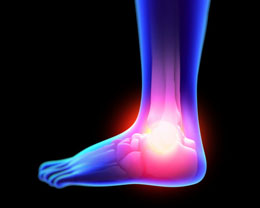Plantar fasciitis and Achilles tendonitis are the major contributing factors for heel pain in the morning. This write-up provides information about these foot conditions.

Do you experience heel pain when you take the first few steps in the morning? Though heel pain could be caused due to trauma or repetitive strain, certain medical conditions could also be responsible for causing pain in the heels in the morning or on getting up after a period of extended rest.
Contributing Factors
Plantar fasciitis is one of the most common causes of pain in the underside of the foot. This condition is caused due to an inflamed plantar fascia, which is the connective tissue or ligament that runs across the bottom of the foot and also attaches to the bones forming the ball of the foot. This band of tissue is padded with a covering of fat which facilitates shock absorption. Since plantar fascia performs the vital function of supporting the arch of the foot, whenever this thick connective tissue gets inflamed, one is likely to experience pain on taking the first few steps. Sports persons, dancers, obese people or people affected by foot deformities such as flat feet or high arches are highly susceptible to plantar fasciitis. Another common cause of an inflamed plantar fascia is wearing ill-fitting footwear.
Bone outgrowths that develop along the edges of the bones are referred to as bone spurs or osteophytes. The formation of bone spurs generally takes place at the meeting point of two bones. These could also develop at places where ligaments meet the bones. These bony projections can press against the surrounding nerves, thereby causing pain and swelling. A bone spur in the heel could be caused due to injuries or overuse of the plantar fascia ligament. Excessive physical activity in the form of running, sprinting, or dancing is the common cause of heel pain in children. Besides these medical conditions, Achilles tendonitis can also give rise to pain. The Achilles tendon is a band of tissue that connects the calf muscles to the heel bone. This tendon can become inflamed due to intense or repetitive strain, which can occur if one increases the intensity of running program or runs on a hard surface. A bone spur can also irritate the tendon, thereby causing pain in the heel.
Treatment
Medical assistance must be sought, if the pain persists. Doctors generally prescribe the use of corticosteroid injections and medications in event of severe inflammation. Since wearing an ill-fitting footwear can aggravate pain, one must be careful while buying footwear. Using orthotic devices or shoes inserts will also prove beneficial. If pain is experienced while running, make sure that you buy shoes that have extra cushioning or padding around the heels. These will not only reduce the stress to the heel bone, but also facilitate better shock absorption.
Since our legs bear the weight of our entire body, one needs to keep one's weight under control. Once the inflammation subsides, one could go for physical therapy sessions. Performing certain exercises will also prove beneficial and strengthen the ligament. If a heel spur is responsible for causing pain, it is advisable to refrain from performing physical activities that might worsen the pain. The use of anti-inflammatory drugs will also provide relief. If the symptoms are very severe and these methods are not really working, then doctors might recommend a surgery for removing the spur.
If you often experience heel pain on taking the first steps in the morning, consult a doctor. Besides taking rest, make sure that you wear good-fitting shoes or orthotic inserts to reduce strain on the heels.
Disclaimer:
The information provided in this article is solely for educating the reader. It is not intended to be a substitute for the advice of a medical expert.


 Do you experience heel pain when you take the first few steps in the morning? Though heel pain could be caused due to trauma or repetitive strain, certain medical conditions could also be responsible for causing pain in the heels in the morning or on getting up after a period of extended rest.
Do you experience heel pain when you take the first few steps in the morning? Though heel pain could be caused due to trauma or repetitive strain, certain medical conditions could also be responsible for causing pain in the heels in the morning or on getting up after a period of extended rest.